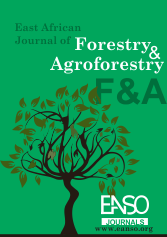Physical and Mechanical Properties of Liquidambar styraciflua as a Potential Timber Tree for Kenya
Abstract
The wood of 38-year-old Liquidambar styraciflua grown in a provenance trial plot in Kenya was studied to determine its physical and mechanical properties as well as the relationship between the modulus of rupture (MOR) and static modulus of elasticity (MOE) of the timber. Mechanical properties determined were MOE, MOR, compression strength parallel to grain, shear strength parallel to grain and Janka hardness. Physical properties determined were moisture content and specific gravity. Physical and mechanical properties of small clear specimens from the L. styraciflua were determined according to British Standards (BS 373:1957) using the Universal Strength Testing Machine. The results were analysed using R statistical software (Version 4.4.2). Three trees were sampled, one from each of the three best-performing L. styraciflua provenances, from trials established in 1986 in Lugari Forest Station, Kakamega County, in western Kenya. The sampled trees were from Honduras, Nicaragua and Guatemala provenances. Tree 1 (Honduras provenance) had the highest average strength for all the properties tested. Tree 6 (Guatemala provenance) had the lowest average strength for MOE, compression strength parallel to grain and hardness. Tree 3 (Nicaragua provenance) had the lowest average strength for MOR. Trees 3 and 6 had similar average strength for shear parallel to the grain. Variations in the strength of the three trees may have been due to their different specific gravities. Average strength values for MOE, MOR, compression strength parallel to the grain, shear strength parallel to the grain, and Janka hardness were 12,399 MPa, 106.3 MPa, 52.3 MPa, 16.6 MPa and 5.8 kN, respectively. There was a significant correlation at 5% significance level (P<2.2e-16) between the MOR and MOE of L. styraciflua; the correlation coefficient was 0.7. Machine strength grading may be suitable for the Liquidambar timber due to its relatively high correlation coefficient. Liquidambar styraciflua from this study had superior properties compared to those of the current plantation species in Kenya; cypress, pines and eucalyptus. This study therefore recommends L. styraciflua as a suitable tree species for plantation growing for sawn timber in Kenya. In Kenya, L. styraciflua provenance trials were conducted at an altitude of 1,600 m above sea level. Provenance trials in lower altitudes could also be established to determine the growing range of L. styraciflua within Kenya. Further research to determine the physical and mechanical properties of graded structural timber from the species is necessary for design purposes. Additional studies are also required to assess the wood’s susceptibility and resistance to biological agents.
Downloads
References
Bijak, S., & Lachowicz, H. (2021). Impact of tree age on selected properties of Black Locust (Robinia pseudoacacia L.) wood. Forests, 12(5), 634. doi: https://doi.org/10.3390/f12050634
Briscoe, C. B. (1973). Sweetgum - an American wood. Research Paper SFES-RP-266, 7.BS 373:1957 Methods of testing small clear specimens. (1957). BSI.
de Lima, I. L., Longui, E. L., Zanon, B., Florsheim, S. B., Garcia, J. N., & Junior, G. B. (2016). Wood anatomy and properties of 24-year-old Liquidambar styraciflua in three diameter classes. Scientia Forestalis, 43(107), 733-744.
Forest Products Laboratory. (2021). Wood Handbook- wood as an engineering material. Madison, Wisconsin: United States Department of Agriculture, Forest Service. Retrieved from https://research.fs.usda.gov/treesearch/62200
Githiomi, J. K., & Kariuki, J. G. (2010). Wood basic density of Eucalyptus grandis from plantations in Central Rift Valley, Kenya: Variation with age, height level and between sapwood and heartwood. Journal of Tropical Forest Science, 22(3), 281-286.
Johnson, R. L. (1985). Sweetgum (Liquidambar styraciflua L.). FS-266.
Kenya Forest Service. (2021). National Forest Resources Assessment Report 2021. Retrieved from https://www.kenyaforestservice.org/national-forest-resources-assesment-report-2021-kenya/
Kenya Forest Service. (2024). Forest Status Report 2024 Kenya.
Maurice, J., Le Crom, M., Bouyer, O., Pesce, F., Cielo, P., Gachanja, M., & Bull, L. (2017). Improving efficiency in forestry operations and forest product processing in Kenya: A viable REDD+ policy and measure. United Nations Environment Programme.
Mbinga, J. M., & Chagala-Odera, E. (2015). Performance of 28-Year-Old Provenances Of Liquidambar Styraciflua At Two Sites In Western Kenya. Octa Journal of Environmental Research, 3(1), 94 - 99.
Mugasha, W. A., Laswai, F. F., Malimbwi, R. E., Chamshama, S. O., Abdallah, J. M., & Mauya, E. W. (2021). Optimal rotation age of Pinus patula in government forest plantations in Tanzania. Tanzania Journal of Forestry and Nature Conservation, 90(3), 130-145.
Mutayi, C. O., Sabuni, B., Waweru, S., & Mwasame, G. (2024). Structural characterization and grading of timber species for engineering applicability in Kenya. Jurnal Teknik Sipil, 20(2), 359-369. doi:https://doi.org/10.28932/jts.v20i2.8310
Ng'ang'a, F. (1992). Strength Properties of Cypress Timber Grown in Kenya. The Commonwealth Forestry Review, 71(3/4), 186-192.
Njuguna, J., Mutitu, E., Mwangi, L., Machua, J., Gichora, M., Mwanza, E., . . . Muthama, A. (2021). A review of insect pests and diseases of major commercial tree species in Kenya. Kenya Forestry Research Institute; Gatsby Africa.
Ogunruku, M., França, Tamara, S. A., França, F. N., Seale, R. D., Arango, R. A., & Quesada, H. J. (2024). Mechanical properties of underutilized hardwood species and potential for use in fabrication of cross laminated timber industrial mats. Forest Products Journal, 74(3), 233- 241 doi:https://doi.org/10.13073/FPJ-D-24-00013
Rocha, M. F., Veiga, T. R., Soares, B. C., Araújo, A. C., Carvalho, A. M., & Hein, P. R. (2019). Do the growing conditions of trees influence the wood properties? Floresta E Ambiente, 26(3). doi:10.1590/2179-8087.035318
Ross, R. J. (2015). Nondestructive Evaluation of Wood. Madison, WI: United States Department of Agriculture, Forest Service, Forest Products Laboratory.
Simpson, W. T. (1998). Equilibrium Moisture Content of Wood in Outdoor Locations in the United States and Worldwide. 11. Madison, WI: U.S Department of Agriculture, Forest Service, Forest Products Laboratory.
Thelandersson, S., & Larsen, H. J. (2003). Timber Engineering. West Sussex, England: John Wiley & Sons Ltd.
Copyright (c) 2025 Benjamin Mukoya Amukambwa, George Mbeva Muthike, Kelvin Mumo Levu, Mary Wairimu Gichuki, Benjamin Mwangangi Mutinda, Joseph Kabucho Githiomi, Joram Makaka Mbinga, Martin Om'mala Welimo, Mitchel Akinyi Oluoch

This work is licensed under a Creative Commons Attribution 4.0 International License.




























